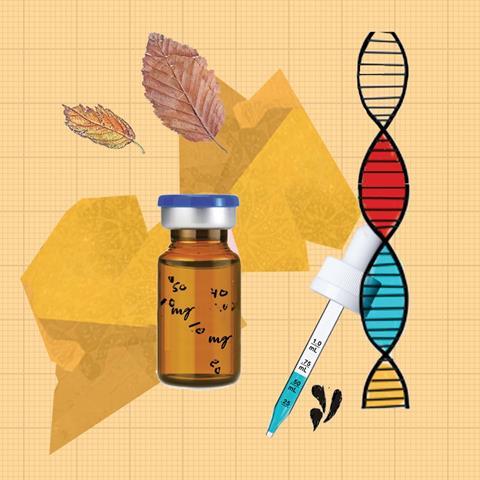We are now living longer than ever before, but not always in perfect health. Anthony King talks to the researchers working to extend our healthspan
Immortality is a human obsession, sought throughout history, literature, art and religion. Immortality spurred Frankenstein on to make his creature, while it fixates Lord Voldemort in the Harry Potter series. China’s first emperor Qin Shi Huang sought an elixir of life but even he failed. Lifespans have greatly extended in the past century, but living forever remains as far away as ever – although many scientists believe we will be able to slow down ageing and live healthier lives.
Ageing is complex, associated with an accumulation of damage, loss of function and increased vulnerability. Today, on average, a person will live decades longer than a Bronze Age farmer, and longer than their 19th century forebears. As human lifespan continues to creep forward, now exceeding 70 years globally and over 80 in OECD countries, our number of healthy years lived has stalled. ‘More and more people are reaching an advanced age, but also [living in] poor health for a larger portion of their life,’ says Colin Selman, a researcher into ageing at the University of Glasgow in the UK. In his labs, researchers have switched focus from mice living longer to them living healthier lives as they age.
Most of us are trying to understand how to live a healthier life
‘The emphasis is no longer on extending life,’ agrees Ilaria Bellantuono, a stem cell biologist at the University of Sheffield in the UK. ‘Most [of us] are trying to understand how to live a healthier life.’ There’s a shortlist of compounds that scientists believe could offer real anti-ageing benefits: metformin, glucosamine and rapamycin are the main contenders. Optimism is driven by findings, starting in the 1990s, that changes to genes can dramatically affect lifespan in lab animals. This offered hope that drugs could modulate ageing. ‘Our institute here is founded on the paradigm that the rate of ageing can be changed,’ says Eric Verdin, head of the Buck Institute for Research in Aging in California, US. Start-up companies with anti-ageing strategies are moving towards clinical trials, and some putative age-slowing drugs are being trialled for age-related diseases. Since there is a long list of common conditions that rarely afflict young people, there must be common processes or causes linked to ageing that help drive them.
How to live longer
Calorie restriction is a long-proven strategy for extending how long organisms live, from yeast, bacteria and worms to flies and mice. It works because limiting food hits a pause button for growth and reproduction, and instead encourages maintenance and rebuilding. Its biological impact has become better understood in recent years. ‘Calorie restrictions changes hundreds of genes. It is not subtle,’ says Verdin. ‘It puts organisms in a state more resistant to stress.’ This could also be how exercise can combat ageing.

Our cells have nutrient sensors to determine food availability. ‘These sensors regulate large gene programmes that themselves regulate the ageing rate,’ Verdin explains. Unfortunately, eating 20–40% fewer calories than normal is not a desirable or perhaps even healthy lifestyle for most people. The hunt is on for molecules that can replicate calorie restriction for its anti-ageing effects – a term which is taboo for many in the field, with its connotations of pseudoscience.
Anti-ageing in medicine sits on a firm base of solid science, however, unlike many cosmetic products with anti-ageing claims. There is even a billion dollar company linked to a breakout discovery – senescent cells. In vertebrates, these cells build up in all types of tissues as they age. Senescence is a life saver: it causes a cell to secrete protective compounds and to stop dividing, which protects against it becoming cancerous. Mice – and people – with mutated genes that stop senescence die an early death from cancer, says Judy Campisi, a scientist at the Buck Institute who pioneered senescence research. Senescent cells secrete hundreds of compounds, many of which promote inflammation, which helps repair tissue. But there is a downside. ‘Some of these molecules are a double-edged sword. When chronically present, they promote chronic inflammation, which is a major contributor to every major age-related disease,’ says Campisi. Worse, senescent cells tend to accumulate with age and coax neighbours to enter a zombie-like state too.
Poor diet, obesity and smoking in particular push cells towards senescence. 10 years ago, Campisi’s lab helped describe around 40 different molecules they secrete, but today hundreds are known. Many are pro-inflammatory cytokines, small proteins that initiate and propagate inflammation. ‘These cells are present at the right time and place to be driving a range of pathologies. They are a smoking gun,’ Campisi explains. Senescent cells are vital to prevent cancer, but can make life miserable in our old age. ‘This is a tumour-suppressive mechanism that can also drive cancer later in life, ironically,’ Campisi told an audience at an anti-ageing session at the Basel Life conference in Switzerland last October. ’If you are not depressed, you weren’t paying attention.’
Campisi is on a mission to kill these persistent cells, using senolytic agents. A number of companies are developing them. The leader is Unity Biotechnology, a company based in San Francisco, US, that grew out of work in Campisi’s lab and others. In 2018, Unity announced it was targeting senescent cells in patients with osteoarthritis of the knee. Injecting senolytics into arthritic lab mice killed the senescent cells and allowed mice to walk better.
Senescent cells are present at the right time and place. They are a smoking gun
A study at the Mayo Clinic in Minnesota, US, used a transgene to kill senescent cells in mice and saw a significant increase in their healthspan. Their maximum lifespan didn’t change: they still died like the untreated animals, but they died healthier.1 ‘We are not talking about immortality here – though some Silicon Valley guys would love that – but a healthier life,’ Campisi explains. She believes drugs that wipe out senescent cells could help cancer patients. Adults who were treated for leukaemia as children often look 20 years older than their real age. ‘We suspect this accelerated ageing is due to the presence of senescent cells. If we could kill them off shortly after chemotherapy, patients could recover without too many side effects,’ says Campisi. She sees one hurdle being specific targeting of different types of senescent cells and discriminating between them and normal cells.
Once enough senescent cells accumulate, the environment of a tissue tips towards fibrosis and scarring, rather than regeneration. ‘It’s a first step in dysfunctional tissue and tissue predisposed to develop disease,’ Bellantuono explains. She says initially it was thought stem cells were protected from ageing, but this is no longer believed to be true. Like many scientists in the field, she now views senolytics as the rising star. She is investigating an agent that she believes could stop cells falling into senescence.
‘It has been shown that if you kill senescent cells, even in old age, you regenerate tissue much better and this could prevent the onset of several diseases, including osteoporosis, cardiovascular disease and even some cancers,’ says Bellantuono. ‘These are the drugs that we are most excited about.’ If senolytic agents can be shown to be effective against age-related diseases, and safe, they could be deployed against biological ageing itself. ‘The dream is to develop these drugs to take every few years, to clean out your senescent cells and to restore tissue function,’ says Campisi.
Small molecule targets
A consensus has also emerged that there are three or four biological pathways that are central to ageing. This is bolstered by the discovery that lifespan can be extended by single gene mutations in nutrient-sensing pathways, such as insulin/insulin-like growth factor (IGF). High levels of IGF1 can cause rapid ageing and cancer. Interventions with small molecules in these pathways are under investigation.

Metformin is the most widely taken oral therapy for type 2 diabetes and is on the World Health Organisation’s list of essential drugs. Studies show that long-term treatment with metformin, starting at middle age, extended the lifespan of male mice. One study found a 14% increase in lifespan when treatment with metformin started at three months in mice. First used in people in the 1950s, metformin reduces glucose production in the liver and sensitises organs to insulin. ‘We know it improves mitochondria function, but there are a whole load of other pathways that seem to be affected by metformin, so it’s under investigation,’ says Bellantuono.
Metformin’s anti-ageing impact has been attributed to decreased insulin levels, decreased IGF-1 signalling, inhibition of the mTOR pathway, a reduction in DNA damage and favourable impacts on inflammation and cell senescence. In 2016, scientists in the US proposed a randomised, controlled clinical trial, Targeting Ageing with Metformin (Tame).2 It aims to enrol 3000 patients aged 65 to 79.
Metformin might show anti-ageing potential and be extremely inexpensive, but there is no intellectual property to excite industry. The ambitious Tame trial is still seeking adequate funding, with around half the total sum needed obtained so far. The Albert Einstein College of Medicine in New York, US, is the Tame trial’s sponsor. It notes that a UK prospective diabetes study (UKPDS) compared metformin with other anti-diabetes drug and found a decreased risk of cardiovascular disease. The trial notes say that if it is an anti-ageing drug, it should be associated with less age-related disease in general.
Others are more sceptical. ‘I don’t think it is possible to commercialise metformin for the treatment of ageing,’ says Alexander Pickett, chief operating officer at biopharma company and investor Juvenescence. He credits metformin for piquing his interest in small molecules that could extend healthspan and lifespan in people.
Another interesting molecule is rapamycin, an antifungal compound made by a Streptomyces bacteria discovered in soil from Easter Island. It was found to have immunosuppressive effects, and is used to prevent organ rejection in transplant patients. Research subsequently unearthed the mTOR (mammalian target of rapamycin) signalling pathway, a master controller of cell growth metabolism. Blocking this nutrient-sensitive pathway extends life in yeast, nematodes, fruit flies and mice, and protects against age-related disease.
The mTOR pathway is an accepted regulator of longevity. A 2013 review noted that mTOR inhibitors are already clinically approved. Side effects preclude its use in healthy patients, but ‘drugs that target the mTOR pathway could one day become widely used to slow ageing and reduce age-related pathologies in humans’, the review’s authors wrote.3
The mTOR pathway is switched on when lots of nutrients are present and it stimulates growth and reproduction. If you impair the pathway, or make it less efficient, an organism will prepare for a situation with less nutrients, and begin to conserve and remodel tissue, says Selman. In this way, it is similar to the impact of calorie deficits in lab animals, pressing cells into a ‘repair, maintenance, rebuild’ mode. ‘Rapamycin inhibits a particular complex in the mTOR pathway. If you feed mice rapamycin, you extend their lifespan quite significantly,’ Selman explains. Low doses of rapamycin tunes down mTOR in mice and lengthens their lifespan. In the US, the Dog Ageing Project is treating middle-aged dogs with rapamycin to see if it also improves their health and longevity.
Drugs that target the mTOR pathway could one day be used to slow ageing in humans
The known side effects of rapamycin have pushed companies to search for safer analogues for patients and diseases where it could have most impact. An mTOR inhibitor from Novartis has been shown to improve immune response to the flu vaccine in elderly people, a surprisingly common problem. A trial is now underway and the spin-out company, resTORbio, has obtained results from a phase II trial on the inhibitor (RTB101).
Nicotinamide adenine dinucleotide (NAD), a building block of many important enzymes involved in metabolism, declines with age across multiple tissues and is a major focus of Verdin’s lab at the Buck Institute. ‘We are trying to understand the pathways that regulate NAD+ levels and how we can help keep them stable during ageing,’ Verdin explains. One approach he takes is to provide supplements of small molecules that help cells synthesise NAD+, while another is to inhibit enzymes that use NAD+.
ROS: villains or vaccines?

Reactive oxygen species (ROS) are the pantomime villain of ageing in popular imagination, but the scientific evidence says ‘Oh no it isn’t.’ While it is true that high amounts of ROS cause damage to cells or lab organisms, low levels have the opposite effect and can be beneficial. ‘What we observed was that if we induce physiological doses of ROS, worms live longer, which was unexpected,’ says Michael Ristow, biochemist at the Swiss Federal Institute of Technology in Zurich, Switzerland, recalling his landmark paper.4 Small amounts of ROS alert the nucleus about stress. The cell then turns on an orchestra of genes that boost DNA damage-repair, proteins to detoxify and repair damage and ramp up quality control. ‘To put it into common language, it is like a vaccination,’ says Ristow: ROS primes the cell for insult and injury and triggers repair and maintenance.
Ristow is also excited about the potential of glucosamine, a compound that occurs naturally in the human body. Glucosamine has been taken for a long time to restore cartilage, but Ristow says at least one large study links it to reduced overall mortality and several studies to lower incidences of cancer. It is a mild inhibitor of glucose metabolism, which pushes a cell towards using other sources of energy. The cell then metabolises fatty acids inside mitochondria, the only place they can be safely oxidised. This pumps out ROS, which switch cells into the detox and rebuild mode.
Sugars and starches activate mitochondria far less than fatty acids, Ristow explains; the cell has it too easy. A switch to mitochondria and ROS pushes onto a different track. Ristow says this is somewhat similar to the effect of exercise, when cells start to generate more energy using mitochondria. ‘It comes down to forcing the cell to use mitochondria more efficiently,’ says Ristow. Mitochondria are also more active in a calorie-restricted situation than when the body is overfed.
Ristow stresses that glucosamine causes no side effects. This is crucial. If healthy people in middle age are going to take a preventative drug against unhealthy ageing, they need to be sure that this drug is safe. He argues that glucosamine has an even lower risk profile than metformin, which he describes as a wonder drug, since no one is certain exactly how it works. What is needed for glucosamine and other anti-ageing contenders, he says, is a randomised controlled trial that runs for five or 10 years.
Eat for longer
Rather than mimic the effect of calorie restriction with drugs, Valter Longo, director of the Longevity Institute at the University of Southern California in the US, explored a dietary approach that would not leave people half-starved or taking a drug with unproven clinical efficacy. ‘We have a pretty good picture of how simple organisms live longer,’ says Longo. He too lists pathways in the spotlight for anti-ageing, such as mTOR, IGF-1, PSK and Sirtuin, but he has a slightly different twist on how diet influences them. ‘It is not necessarily an excess of calories. But once you get sugars or amino acids, the systems goes into growth mode,’ he says.
It comes down to forcing the cell to use mitochondria more efficiently
He has developed a ‘fast mimicking diet’, which consists of natural ingredients a person eats for five days. Critically, the person’s body does not recognise that it is being fed, which causes it to enter into a fasting mode. ‘You don’t need to be always without amino acids and sugars to downregulate these pathways,’ Longo explains. ‘There are dietary ways that can affect genes that then affect the ageing process.’ The diet has been clinically tested and is now being trialled in 500 patients with metabolic syndrome. Over 100,000 patients in Australia, the UK, the US and Italy have tried the diet; it has been prescribed by around 15,000 doctors. Longo founded a company called L-Nutra in order to standardise and sell a meal programme, though he emphasises that he doesn’t profit from it. The money goes back into research and medical charities.
‘We’ve shown that cycles of starving and feeding can regenerate the pancreas,’ says Longo. He explains that removing amino acids and sugars causes master regulator genes to switch on stress resistance. Lots of junk gets cleared away. ‘Everything is turned on to minimise damage. Meanwhile, lots of things get broken down. This includes mitochondria, proteins and organelles in the cell,’ says Longo. The cell realises it cannot sustain itself, so starts to downsize and rebuild. While Longo views metformin, NAD+ and rapamycin as legitimate compounds of interest, he says the side effects of any pharma interventions must be considered over a period of decades.
A more holistic approach is to consider ageing from a systems biology vantage. Vadim Gladyshev, a geneticist at Harvard Medical School in Massachusetts, US, notes that even in mammals lifespan differs almost 200-fold. His research on 31 species has identified around 1000 genes in each organ whose levels define how long an organism will live for.5
‘We developed what we call longevity signatures, using gene expression, to define differences between long-lived and short-lived states,’ Gladyshev explains. He has initial data from a screen of 3300 compounds to see which compounds may switch organisms to a longer-lived state. The most promising molecules are now being tested in mice. ‘Our goal is to develop an unbiased approach to identify new compounds or maybe combinations of compounds to robustly extend lifespan,’ he explains. To accelerate this research, they developed an epigenetic ageing clock, represented by 90 sites in the mouse genome, that can quantify ageing and therefore test longevity interventions without waiting for mice to die.6
Hype concerns
One thing all researchers investigating ageing fear is hype. ‘There’s a whole industry of anti-ageing drugs on the market without any evidence that they work,’ Verdin warns. Campisi quips that it is great if we cure disease, but ‘we will be rich if we cure wrinkles’. Unscrupulous claims on cosmetics and supplements cast a shadow over efforts to slow ageing. For now, regulators do not have an approved way of showing when drugs are effective at decelerating ageing. As a result, anti-ageing drugs must target age-related diseases. This is how companies can get regulatory approval and be reimbursed in the usual way. ‘People in the space would love to target ageing in general,’ says Pickett. His venture capital firm has two dozen companies on its radar that are working in this area.
Think of the savings in healthcare
‘We don’t want to overhype the field and say “Immortality is coming on Tuesday kids!”’ says Pickett. He is not worried about the public being unfamiliar with the field’s potential: ‘We can wait until the scientific community has credible data, hopefully over the next 5–10 years.’
Still, researchers talk openly of their hopes. ‘People might start taking these drugs somewhere around early middle age. Think of the savings in healthcare. Around 80% of our health budget is spent on treating people over 65 years,’ says Campisi. ‘I don’t think extension of maximum lifespan is close on the horizon. I do think extension of healthspan is within our grasp.’
Anthony King is a science writer based in Dublin, Ireland
References
1 D J Baker et al, Nature, 2016, 530, 184 (DOI: 10.1038/nature16932)
2 N Barzilai et al, Cell Metab., 2016, 23, 1060 (DOI: 10.1016/j.cmet.2016.05.011)
3 S C Johnson P S Rabinovitch and M Kaeberlein, Nature, 2013, 493, 338 (DOI: 10.1038/nature11861)
4 T J Schulz et al, Cell Metab., 2007, 6, 280 (DOI: 10.1016/j.cmet.2007.08.011)
5 A A Fushan et al, Aging Cell, 2015, 14, 352 (DOI: 10.1111/acel.12283)
6 D A Petkovich et al, Cell Metab., 2017, 25, 954 (DOI: 10.1016/j.cmet.2017.03.016)













No comments yet